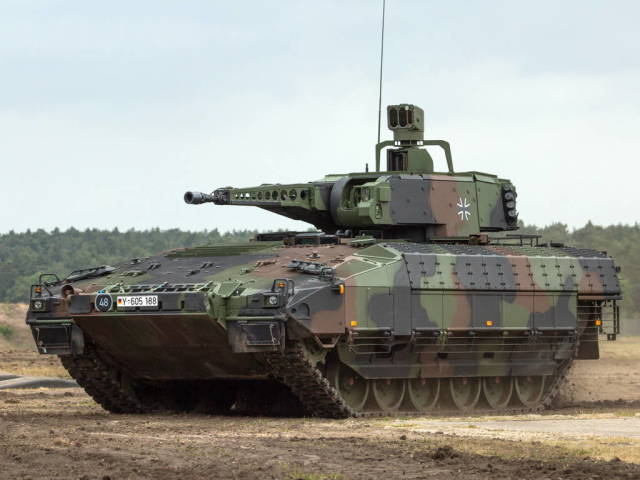The Puma BMP project is designed to significantly increase the combat capabilities of the Bundeswehr motorized infantry, ensuring its mobility and close cooperation with tank units based on the Leopard 2 MBT . At the same time, the strict conditions of budgetary financing of defense expenditures led to the fact that the troops began to develop new equipment only in April 2015.
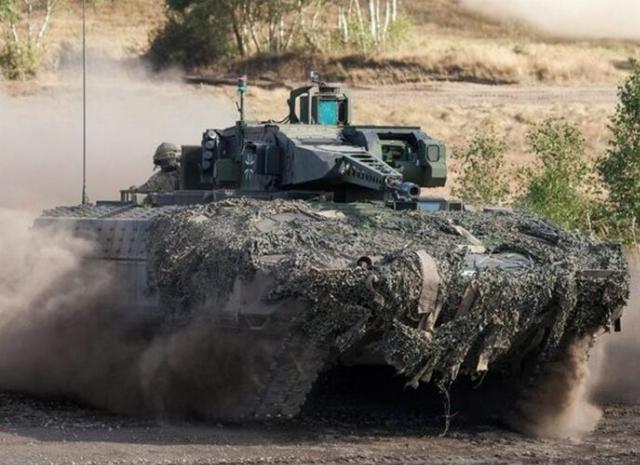
BMP "Puma" of the German Ground Forces
BMP “Puma” – the current state of affairs
As you know, the Puma BMP in the future will replace the Marder BMP, which has long been in service with the German ground forces. According to the Bundeswehr command, in comparison with it, the new combat vehicle “has outstanding characteristics.”
The design of the Puma contains unique technical solutions that made it possible to realize the requirements of maximum protection, increased firepower and high tactical mobility. At the same time, it was possible to maintain the restrictions imposed by the terms of reference regarding the upper limit of the weight of the machine.
The design features of the Puma ensure its compatibility with new developments implemented in the interests of the ground forces. In particular, we are talking about the project of promising combat equipment “ Infantryman of the Future “, the integration of a combat vehicle into the ground forces control information system (Fuhrungsinformationssysteme, FuInfoSys) and the introduction of a new generation of tactical radio communications.
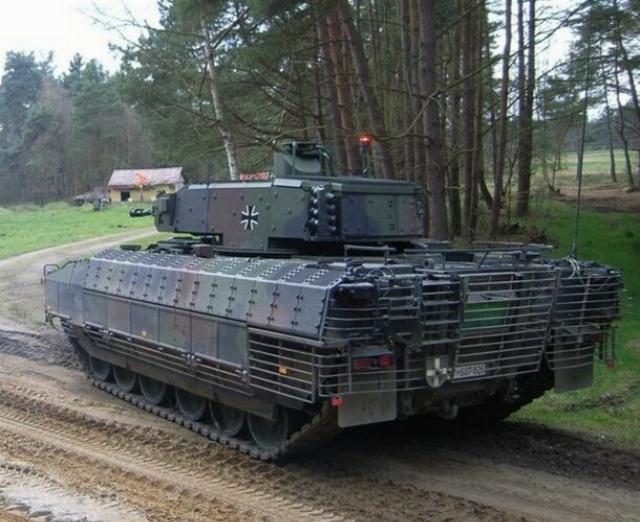
BMP "Puma" at the landfill
Growth diseases
The name of the project “Puma“ is an abbreviation that translates from German as ”armored vehicle for minimal costs" (Panzer Unter Minimalem Aufwand, PUMA). At the same time, the progress of the work is estimated as the most protracted in time. The situation is illustrated by the report of the Ministry of Defense on the implementation of 15 promising weapons projects. The document is submitted annually, in March, to the Defense Commission of the German Bundestag.
The German government has set the deadline for the end of deliveries of the Puma BMP to the troops in 2020. According to data as of March 1, 2018 (the 2019 report is classified), since the beginning of development in 1996 and according to calculations for 2020, the total duration of the project will exceed the initial planned time by 57 months. By value – by 55 percent, or by 1,226 million euros. At the same time, additional costs for the improvements of the BMP and training facilities will amount to 585 million euros.
The main contractors for the production of the Puma BMP were the Krauss-Maffei Wegmann (KMW) and Rheinmetall-Landsysteme (RLS) concerns. The concept of the vehicle is based on the project of the “new armored combat platform” (Neue
Gepanzerte Plattform, NGP). The project involved the creation of a universal tracked base for various weapons systems.
The first few demonstration samples were made in 2005, and in 2006 they were transferred to the troops. Further tests revealed numerous flaws in the design, software and other elements of the platform. Their elimination led to a delay in deadlines and a significant increase in costs.
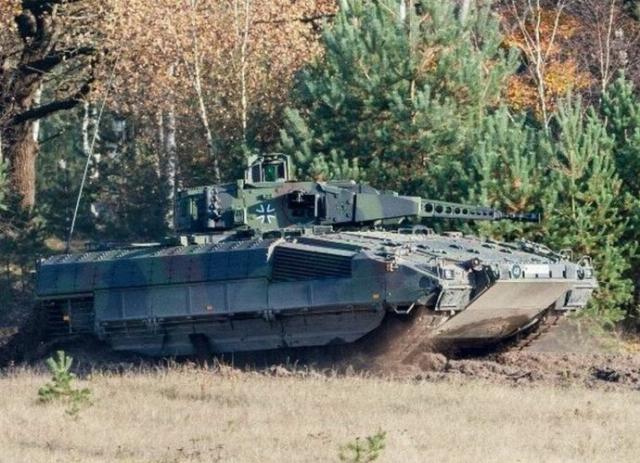
Side projection
Realization
The first seven serial IFVs were placed at the disposal of the CB training center in Munster in April 2015. Specifically for the Puma IFV, a structure for the introduction of new military equipment into the troops (Einführungsorganisation, EFO) was deployed on the basis of the center. Within the framework of this unit, training of instructors began in April 2015.
According to the signed agreements, the industry will supply 350 Puma combat vehicles to the Bundeswehr ground forces. According to plans, by March 2018, their number in parts should number 237 cars. In reality, there are only 199. At the same time, the 2018 report notes the manufacturer's efforts to eliminate the backlog. So, in 2017, instead of the planned 62, the manufacturer handed over 71 cars to the Bundeswehr.
The achievement of full combat readiness of the entire Puma BMP fleet is scheduled for 2025.
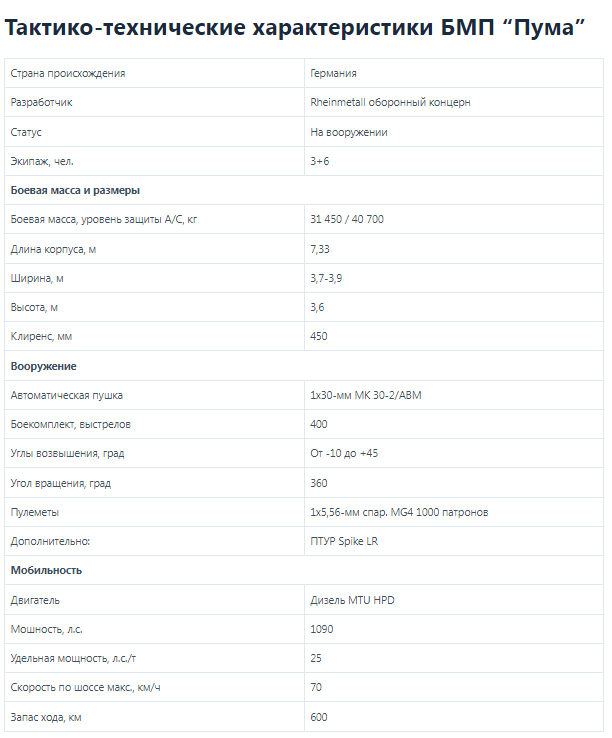 |
| Tactical and technical characteristics of the BMP “Puma". |
| Source: invoen.ru |
Design features
The Puma BMP is an armored infantry fighting vehicle with an uninhabited remote–controlled turret. In its basic configuration, the machine is suitable for transportation by the new German Air Force Airbus A400M military transport aircraft . The overall layout of the BMP is designed with an emphasis on the combat use of the crew in combination with a tactical infantry group.
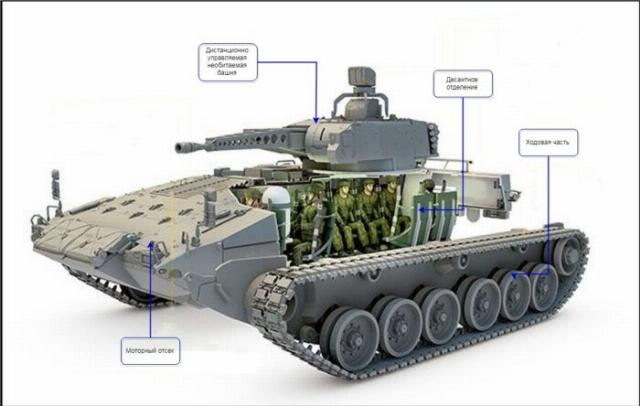
The layout of the BMP "Puma"
The crew of three people (squad commander, gunner-weapon system operator, driver mechanic) are constantly in the car. The tactical group includes a commander and five infantrymen: a machine gunner, a grenade launcher, a sniper and two shooters. In exceptional cases, at the expense of the squad commander, the number of the tactical group increases to seven people. Then the crew of the BMP is headed by a gunner-operator.
The tactical group operates both from the troop compartment of the vehicle and on foot. Due to the continuous internal combat space, direct communication of all personnel on board is possible.
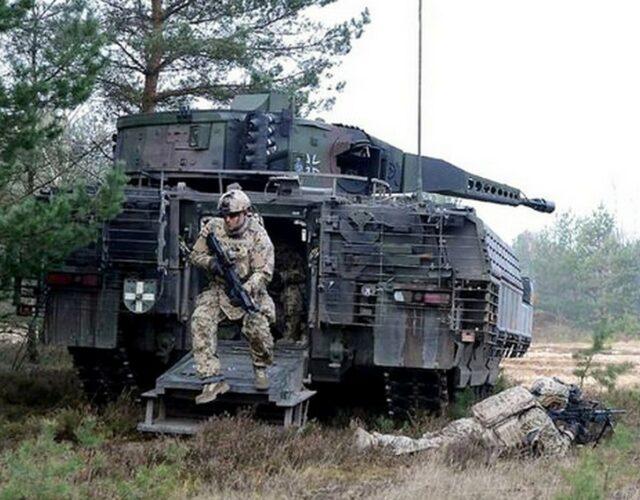
Dismounting the tactical group through the back door
Accommodation of the crew and troops
In the car, the driver is in front on the left. The gunner-operator is located behind him. He controls the weapon system and sits in front of the turret's rotary mechanism. The place of the squad commander with a sliding hatch is to the right of the gunner. Due to the asymmetric location of the turret on the left side of the vehicle, the squad commander can communicate with the tactical group in the landing compartment of the vehicle.
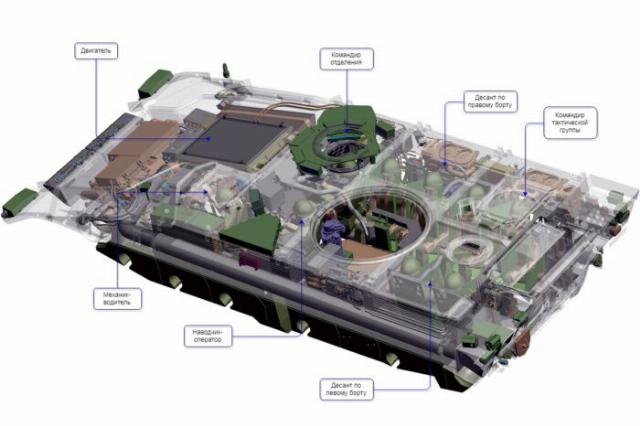
Accommodation of the crew and troops of the BMP "Puma"
The personnel of the landing force sits with their backs to the outer sides of the vehicle: four infantrymen on the right and two on the left. The central shelf under the tower serves as a place to store equipment. All internal equipment is made in a mine-resistant style and has no contact with the bottom of the BMP hull.
The size of the landing compartment has been increased, which made it possible to place a sunroof for two people and improve the security of the vehicle from the rear. The rear door has a bulletproof glass window, which is closed from the inside with a sheet steel flap.
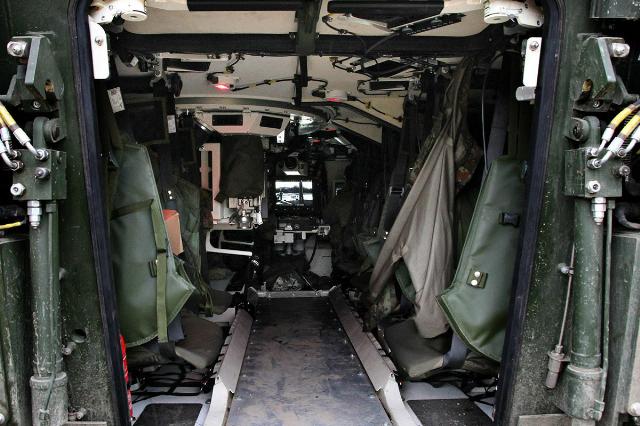
The landing compartment of the car
The protection system of the BMP “Puma”
The Puma armor is modular and has two levels of protection. The “A” protection option is the smallest, but it allows you to transport the car by an Airbus A400M military transport aircraft. In this case, the mass of the BMP with attachments does not exceed 32 tons, and the weight of the additional equipment carried is limited to 1 ton.
At the “A” level, the Puma BMP is protected from portable anti-tank weapons (for example, RPG-7), medium-caliber shells (up to 30 mm), artillery fragments, as well as heavy mines weighing up to 10 kg.
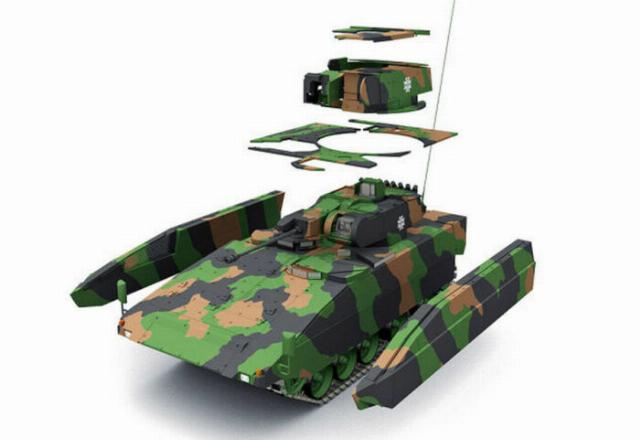
Additional booking scheme
The protection level “C” (combat) is achieved by using an additional modular reservation. It includes tower protection, frontal protection, side and roof reservations. As a result, according to the manufacturer, the BMP is capable of resisting anti-tank weapons, medium-caliber projectiles and aviation cluster munitions (Bombletts).
In addition, serial BMP with protection level “C” are equipped with reactive armor (ERA) from Dynamit Nobel Defense Group. Additional side skirts cover the drive up to the middle of the rollers. The Bundeswehr has purchased a total of 200 sets. The weight of one set is 1 ton and contains 500 kg of explosives. The time to install reactive armor reaches 3-4 hours.
The Puma BMP is equipped with an anti-WMD protection system manufactured by Dräger. Exhaust gases are mixed with fresh air and ejected to the left of the chassis to reduce the infrared signature. Further reduction of infrared radiation is achieved with the help of an appropriate camouflage coating.
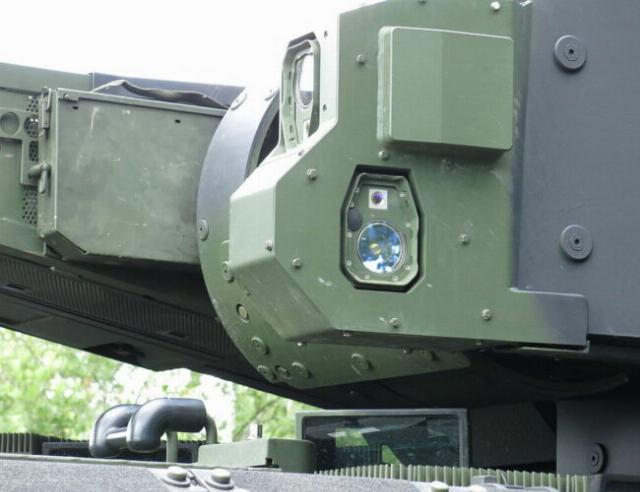
Elements of the MUSS system on the tower
An active interference and suppression system of the MUSS type, from EADS, designed to counter guided anti-tank missiles, is additionally mounted on the BMP. The possibility of equipping the machine with an active protection system is also being considered.
After hanging the entire set of protective equipment, the total weight of the machine increases by more than 9 tons. The ability to configure protective elements allows you to achieve the required level of security, depending on the likely degree of threat. All protective components are capable of functioning autonomously. The failure of some elements does not affect the efficiency of others.
Armament and fire control
The main armament of the BMP “Puma" is a fully stabilized automatic 30 mm gun MK 30-2ABM manufactured by Rheinmetall installed in the tower. The gun is capable of conducting a circular bombardment of targets (360 degrees) with a high probability of defeat. The elevation of the angle of the target location is in the range from -10 to +45 degrees. The maximum firing range is up to 3000 m. The fire is being fired from a place and in motion.
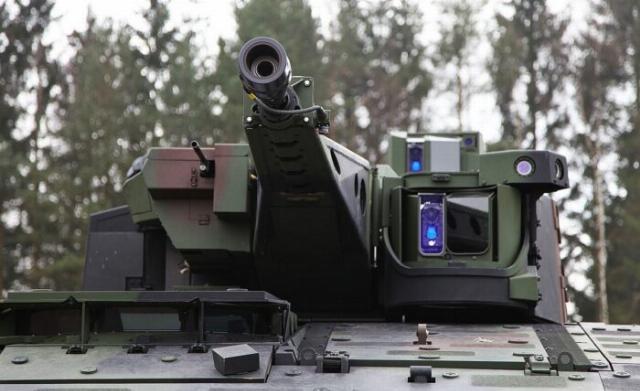
Automatic cannon and twin machine gun BMP "Puma"
There are two types of shots in the ammunition of the gun: the main ammunition with increased penetration capability of APFSDS, as well as the Air Burts Munition. The latter is triggered in front of the target, according to the time set on the fuse. The enemy is hit by a cloud of 162 cylindrical tungsten striking elements weighing 1.24 grams. Programming for detonation occurs during the shot.
The gunner-operator has the opportunity to choose the type of ammunition. The shells are fed automatically from a 200-round gun magazine. The total ammunition of the gun is 400 rounds.
In addition to the main gun, a fully stabilized 5.56 mm MG4 machine gun with 1,000 rounds of ammunition is mounted paired with it. For anti-tank and helicopter defense of the Puma BMP, it is planned to equip the Spike LR ATGM of the German-Dutch-Israeli armed consortium EuroSpike GmbH. Currently, the fully integrated multifunctional ATGM launcher “Mels” serves as a launch pad (Mehrrollenfähiges Leichtes Lenkflugkörper-System, MELLS). It is mounted on a tower and accommodates two missiles.
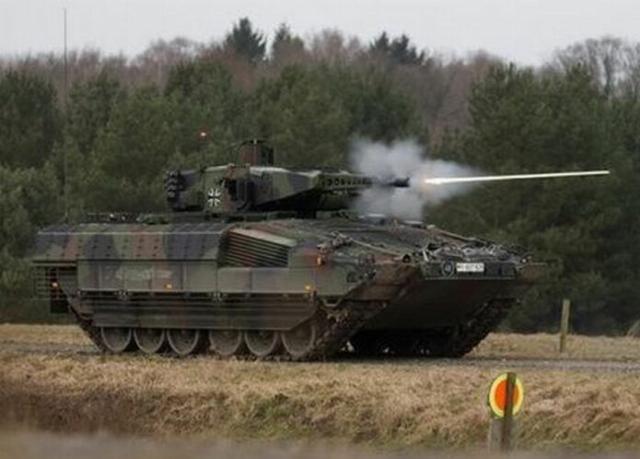
Firing from the automatic cannon of the BMP "Puma"
Auxiliary weapons
In addition, the Puma BMP is equipped with several types of auxiliary weapons.
For protection at close range (50 meters), the vehicle is equipped with a 76 mm grenade launcher (Sprengkörperwurfanlage, SKWA). The installation is located in the rear of the machine, on the left and has a 90° rotation angle around the stern of the BMP. The control is carried out by the commander of the tactical group.
The propellant for 40 mm smoke grenades is based on the systems in service. Two groups, each with four throwing cups, are located on the back side of the tower. Smoke grenades can be launched individually or all together.
Two shooters from the landing party can fire from an IFV from their personal weapons.
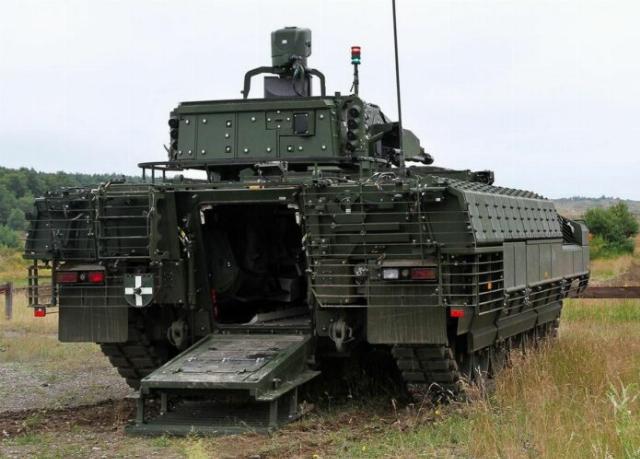
Aft projection of the BMP "Puma"
Surveillance and guidance devices
The Puma BMP has a tower-independent stabilized main optics (PERI, RTWL-B) for the squad leader and the commander of the tactical group. Specially protected stabilized optics for pointing weapons are provided at the disposal of the gunner. Both systems manufactured by Hensoldt Optronics have a day vision channel, an ATTICA thermal imager and an LDM 38 laser rangefinder.
The periscope has four fields of view. In populated areas and at close range, the squad commander uses a field with a 60°×45° sector. Three more fields of view with magnification up to 16x are available for observation, target identification and aiming. In addition to digital display, surveillance can be conducted through an optical channel with laser eye protection. The Nd:YAG laser is used to determine distances. It takes measurements with an accuracy of up to 5 m at a distance of 200 m to 40 km.
Images of the main optics using a CCD camera are shown on two monitors for the squad and tactical group commanders. Information about the day or night channel, the position of the tower, distance, aiming marks, navigation and system data are displayed on the screen. Thanks to digital signal processing, the entire surveillance and targeting complex is compatible with the network, and information can be transmitted to existing Bundeswehr combat control systems.
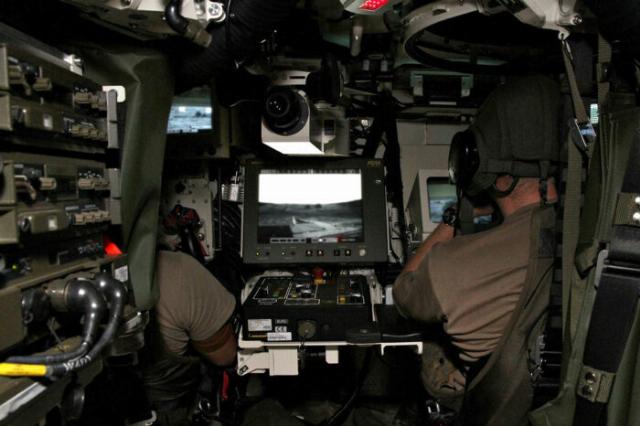
The jobs of the gunner (left) and the squad commander (right)
The optics of the weapon, combined with the Puma fire control system, allows the shooter to hit targets while moving. The gunner-operator of the weapon also has a daytime CCD camera with a zoom lens and three fields of view. The driver's seat is additionally equipped with a night vision device and has a rear-view camera screen.
Fire control system
The main armament complex allows the commander of an IFV or a gunner to respond to enemy actions with appropriate weapons commensurate with the threat. A fire control system built on the principle of “hunter – shooter”, which ensures the defeat of several targets in a very short time.
The high reaction speed of the crew is achieved by equipping the combat positions of the commander and gunner with independent means of reconnaissance and weapon guidance. This allows the commander (“hunter”) to detect new targets while the gunner (“shooter”) is firing at a previously explored enemy. A mark is placed on the detected targets, and weapons are aimed at them automatically. The fire is opened by the “shooter" by pressing the button.
According to the estimates of the Bundeswehr Command, the entire range of weapons of the Puma BMP guarantees it a very high level of combat capabilities both in high-intensity conflicts and in other operational conditions.
Engine and drive
A number of new innovative solutions were implemented in the undercarriage of the Puma, which provided the BMP with high tactical mobility comparable to the main battle tank of the Bundeswehr Leopard 2.
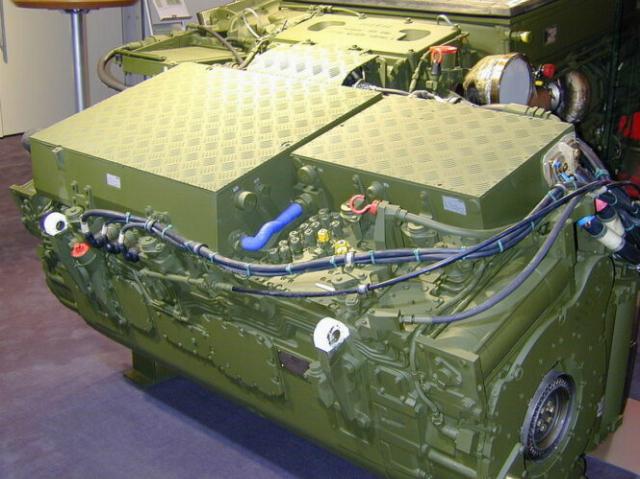
The diesel engine of the BMP "Puma"
Optimized in weight and volume, the 10-cylinder high-power diesel (High Power Diesel, HPD) from MTU in combination with a hydrodynamic gearbox, a transient transmission mechanism and a steering gear form an absolutely new type of drive with a power of over 800 kW (1090 hp). At the same time, fully equipped with a machine weight of 43 The T drive guarantees a specific power of more than 18 kW/t (25 hp/t).
The engine is equipped with a starting generator with a flywheel and central power electronics with a rated power of about 170 kW. The energy is used to power two fans, as well as drive the refrigerant compressor in the air conditioning system. The on-board electrical network with a voltage of 24 V is powered from the power electronics. The connection takes place through a bidirectional converter with a current strength of up to 800 A. Through it, the BMP diesel engine is started from the car battery.
For the first time, a chassis with individual hydropneumatic shock absorbers has been implemented in the design of a combat vehicle. The chassis is in contact with the machine body only through rubber elements. This reduces the structural noise level from 120 dB to about 96 dB.
Together with the built-in fuel tank, this design not only gives weight advantages over a conventional torsion bar suspension, but also improves mine protection, allows optimal adaptation to various additional suspension elements and significantly improves ergonomics for the crew.
The caterpillar of the BMP “Puma” from Diehl consists of a steel pipe with a rubber compartment and rubber upholstery. As a result, according to the requirements of air transportability, the DLT 464D caterpillar is 40% lighter than the Leopard-1 MBT caterpillar, but has the same strength. Initially, it was planned to have only five pairs of rinks on each side. According to the results of driving tests, the car received an additional sixth pair of support rollers.
Communications
The machine is equipped with an on-board internal Thales SOTAS IP intercom and SEM 80/90 (VHF) and HRM 7400 (HF) radio communication systems. An on-board CENTURION computer from ATM ComputerSysteme is installed to process information. The radio stations are connected via an additional KommServer computer. The on-board information system of the BMP “Puma” is controlled using a 15-inch LCD display (MDU), which hangs in the center under the periscope and is accessible to the gunner and the squad commander.
It is reported that due to the use of Ethernet data transmission technology based on international industrial standards such as CAN-Bus, BMP interfaces can be connected to promising control and communication tools. We are talking about projects specialized for the Bundeswehr military, designed to implement the management of troops in a single information space: the management information system (IFIS), the promising equipment of the Infantry of the Future, the unified input server of the Bundeswehr (QUAKS KommServer), satellite communication systems Satcom of the Bundeswehr (SatCom Bw) and software-defined tactical radio (Defined Radio).
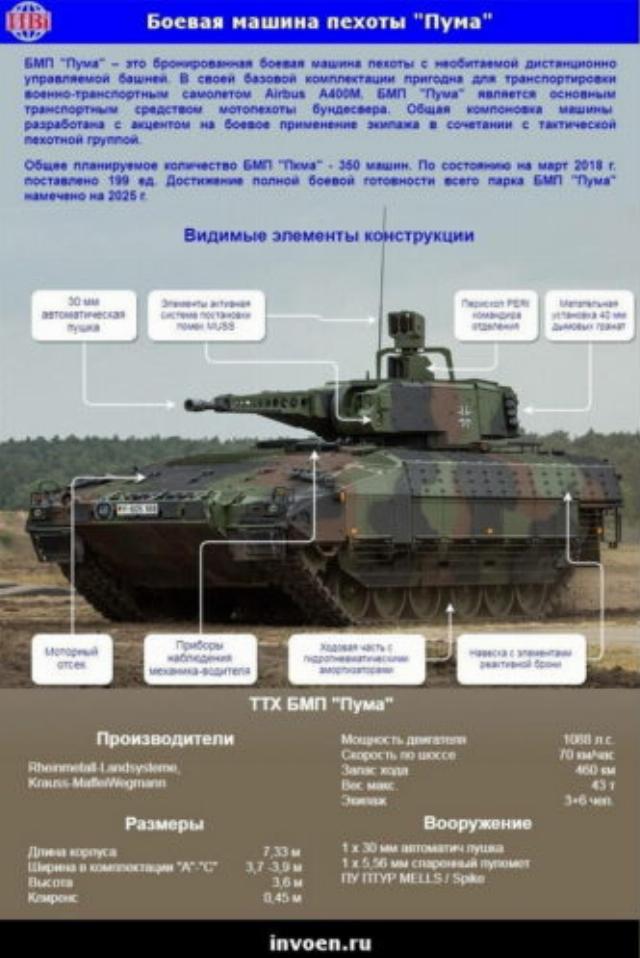
BMP "Puma". Infographics
In conclusion
According to experts, the Puma BMP is a modern weapon system suitable for long-term combat operations across the entire spectrum of operational scenarios. The high combat capabilities of the BMP are guaranteed by its mobility, the security of the vehicle and crew, as well as the installed weapons systems, target reconnaissance and combat control.
The delivery of 350 BMP Puma vehicles to the German ground forces, which began in April 2015, is designed to significantly increase the combat capabilities of the Bundeswehr motorized infantry. At the same time, underfunding, combined with flaws in the design itself, turned the Puma project into one of the most expensive and time-consuming.
On the subject of the BMP “Puma":
- BMP “Puma” will receive its own AGDUS simulator
- “Infantryman of the future" – promising equipment for a soldier of the Bundeswehr
Based on the materials of the resources http://www.wikiwand.com/de, https://www.deutschesheer .de and the journal Europäische Sicherheit & Technik.
